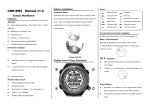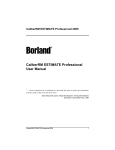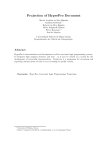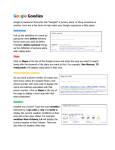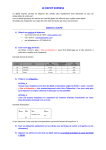Download C:\WINDOWS\Desktop\Solar Calculator\Solar
Transcript
Solar Energy Analysis Tool User’s Guide Copyright (c) RCS Energy Services, 2007 resourcetechnology.org General Information Understanding what is provided The is a free tool. It provides reasonably good, site-specific, solar savings information that a non-technically orientated home owner can use. Since its creation was pro-bono, it is a fairly bare-bones utility. Understanding this should help calibrate expectations with respect to the plainness of the interface, and absence of input flexibility in some areas. Nevertheless, what makes this tool especially useful, is it calculates heat losses through windows with or without insulation. Thus it provides a net savings estimate. It also provides estimated reductions in CO2 emissions based on fuel savings. It is almost impossible to make precise predications when working with these kinds of solar calculations. Nevertheless, over 20 years experience went into this tool’s creation; its results are in sync with my 19 year old, passive solar home. It should provide information sufficient for ballpark savings estimates for residential: direct gain, solar hot water and photovoltaic projects. Understanding what is required Solar calculations have many variables, such as: latitude, declination from solar south, seasonal variations in clear-sky conditions, monthly variations in solar angles, glazed surface area, number of layers of glass, tree shading, heat losses through glass during times of non-solar gain, and potentially, nightinsulation. When fuel savings are added, one must include the heating and hot water systems’ overall efficiencies, energy content of fuels and their cost. In short, a certain minimal amount of information needs to be provided before reasonable, site-specific estimations can be generated. Use Agreement This tool is essentially share-ware. You are welcome to copy it as often as you like, and give it to friends, enemies and relatives. However, it is not public property; and it is an infringement of copyright (RCS Energy Services (c) 2007) to incorporate it into a program, or use it commercially. This tool only provides the results of energy calculations. The results are not “recommendations” as such. We also have no control over project installation. Therefore users must agree to hold harmless both RCS Energy Services and the Town of Leverett for damages that could be associated with the use of this tool; including, but not limited to, failure of a measure to realize estimated savings. Use of this tool confirms agreement to these terms. Table of Contents Section I - Data Input Information About Data Input Clear Day Weather Day input..................... Location Adjustments.................................. Glazing......................................................... Shade Free Area Factor for Windows........ Window Insulation...................................... Surface Area................................................ Space Heating Information........................ Building a Greenhouse................................ Using Your Roof to Capture Solar Energy. Direct Space Heating (Under Roof)............ Solar Hot Water........................................... Solar Cells/Photovoltaics............................. Page 1 Page 1 Page 1 Page 2 Page 2 Page 3 Page 3 Page 4 Page 5 Page 5 Page 6 Page 6 Section II - Results & Other Information What the Results Mean Understanding the Results.......................... What Heat Loss Means............................... Wood Heat and CO2 Production................ Solar Gain and Air Conditioning............... The Perception of Warmth ........................ Page 7 Page 8 Page 8 Page 8 Page 8 Both the tool and this text are narrow so they can be loaded and viewed sideby-side. *Email questions etc. to- “info” at resourcetechnology.org. Data Input Information about DATA INPUT Scroll down to continue data input. Look over the input screens; then only fill in data that apply to measures you’d like estimates for. Clear Day Weather Data These codes are indexed to weather tables and latitude data to refine calculations. The more clear days, and more direct the angle of the suns rays, the more solar energy penetrates the glass. The input is also indexed to Degree Day information which helps determine how much warmth will leave the space at night. This box must contain a code. Location Adjustments Accuracy will diminish as one goes beyond Massachusetts. Results for areas of NY, CT, RI, NH and VT within 35 miles of MA should be reasonable (check which county in MA is closest). If you wish to use this tool for areas outside this range, please forward local or regional weather data, including: seasonal sky cover data; monthly solar heat gain data for a south facing vertical surface; and Degree Day data to the resourcetechnology.org website. Once you are there, E-mail the information, via the e-mail link, to “info.”. Adjustment factors will be estimated and forwarded as time allows. (The requested weather data really isn’t that hard to get.) Glazing (windows) These codes are indexed to the insulating value of the windows’ (glazing), and their resistance to solar energy. The more layers of glass, the more insulation and impedance to the suns rays. In order to keep data input easy, while still meeting most needs, only one selection is allowed. If the space has both single and double paned windows, run the program once for each, then add the results. Estimates are based on October through April solar gains. The results for single glazing will provide a scientifically defendable value. Although cloudy-day and evening heat losses are subtracted from savings estimates, heat gains for single glazing would still be considerable. However, in practice, a fair amount of the heat gained will be lost through conduction, infiltration and some even re-radiated back to the outside unless window covers are used. Single glazing is not recommended for living spaces unless significant steps would be taken to retain and store solar heat. Solar south, in Leverett, is about 13 degrees west of magnetic (compass) south. 1 Not all scenarios will result in net savings. For example, even southwest facing windows with minimal shading, can be net energy-losers if curtains or some form of night insulation aren’t used. Window Insulation This may require some additional information. The R value of a material is its ability to impede heat flow. The higher the R value, the less heat we lose. For example, the punky, fibrous, rigid insulation with the shiny, foiled surface, has an R value ranging from 7.1 to 7.7 per inch of thickness (this type of insulation should probably not be used indoors). Blue board has an R value around 4.5. Blanket type, inside insulations can also vary widely; ranging in R values from, say, 3 to 6 depending on composition. Regular curtains can range from probably 1.0 to 3.0; and even shades can provide some help. Rigid panel window coverings can offer R values ranging from 4 to 7, but can be either more cumbersome to handle or mechanically challenging to install. Although blanket style, inside, window insulation can be the most expensive, and technically the least effective, their aesthetics and ease of use usually render them the system of choice. Also, note that most of the savings come from the first few “R”s. The reason for this would take yet another paragraph to explain. It should not be difficult to obtain the specific R value of a system once it has been selected, either by asking the seller or by checking the manufacturers literature. Whatever inside system is installed, care should be taken to restrict air movement between the glass and insulation. Glass surface heat loss calculations include air films along with evening and cloudy day losses. Shade-Free Area Factor for Windows This question is important and requires some thought. You are asked to estimate what proportion of a surface is exposed to direct sunlight. You don’t have to supply information about all windows and walls, only those which pertain to your solar project. In many cases you’ll have to average across many windows. That’s OK, just do your best, but remember, the estimates you get can only be as good as the information provided. Inexpensive tools are available to help with this assessment; the Solar Pathfinder and Solar Site Selector are just two examples; both can be “Googled.” (found on the web). As a very course rule of thumb, a single deciduas (leafy) tree will let about twice as much solar energy through in the winter as summer. 2 It is important to remember that you are inputting a decimal value that represents the portion of the surface exposed to the sun, not the square footage, nor the amount shaded! Example of data input: November - April May & October June - September East 1 .9 .7 The box at the left indicates that the East facing windows have full sun from Nov. through Apr, 90% for May and Oct., and, 70% from Jun. through Sep. Surface Area This applies to the total square footage of glass facing a given direction. For example, if you have 8 south facing windows that are six square feet each, you would enter “48" in the box under the word “South.” Any data entry in this table should have information in the previous table (Shade-Free Area Factor for Windows) for windows facing the same direction. For example, if you input “48" under “South” in this table, then the “ShadeFree Area Factor for Windows” table above, should have shade-free data under “South” as well. To convert from square inches to square feet: If necessary, measure the dimensions in inches, multiply the width times the height, then divide that answer (product) by 144 to get square feet. There are 144 square inches in a square foot. Space Heating Information Enter the temperature you would ordinarily heat the space between 3:00 P.M. and 9:00 A.M. during the heating season. This information is used to calculate heat loss through glass during periods with little or no solar gain. It is also used for night-time window insulation savings estimates. Take a moment to look over the Heating Systems section; information entered here effects fuel use and CO2 emission reductions. Most should know what type of heating system they have, and what fuel provides space heat (see Heating System Codes and Fuel Codes on the data input screen). 3 Heating System Information “Heating System 1 and Heating System 2.” Enter the “Heating System Codes” and “Fuel Codes” as indicated on the screen. If you only have one heating system, then only enter data for the system on the left (Heating System 1). “Enter the contribution of each here” If you only have one heating system, enter 1 in the left column. If more than one, enter a best-guess contribution, in terms of heat provided by (not annual fuel cost of), each system. For example, if you heat more with oil than wood, then System 1 might be “0.6", and System 2 might be “0.4”. The values must be entered as decimals; and, when added together, equal “1". “Enter fuel cost per unit here” What does it cost, in dollars and cents, for each unit of fuel you buy. For example, $2.00 per gallon of heating oil, or, $0.168 per kilowatt hour (kWh) of electricity (take care to omit transmission charges when figuring electricity costs). Building a Greenhouse Putting a “1” in the box tilts the southerly glass to 60 degrees from horizontal (as opposed to 90 for a standard wall). Thus the space will get more solar gain. Be sure to input the code that most closely represents the variance (declination) of the southerly wall from solar south. Solar south, in Leverett, is about 13 degrees west of magnetic (compass) south. This section relies on the above window data; do not include any house data if evaluating a greenhouse. Greenhouses vary greatly in composition and structure, and sometimes even function. Accommodating those variables would require a larger tool than can be offered at this time. What can be provided is a rough idea of gains and losses through glass surfaces. If you wish to use plastic, the materials seller should be able to provide a conversion value to adjust savings and losses from glass to plastic (there are many different types of plastics used). For this tool to provide a greenhouse estimate: If the easterly and westerly walls will be glass, include them in the window sections above, otherwise omit that data. If the roof will be glass, and is about 45 degrees from horizontal, put that information in the “Using Your Roof to Capture Solar Energy” Direct Space Heating section. If window insulation has been recommended, it will be applied to the glass walls and glass roof. 4 Although the solar gains and losses estimated through southerly glass are calculation based, easterly and westerly windows are assumed to balance out up to around a 20 degree declination (from east and west); one end of the greenhouse being more southerly, the other more northerly. After about 20 degrees, the end-wall glazing estimates are no longer valid. In most cases this should not be a problem, since home-attached greenhouses usually do not have glass end-walls. Estimates are based on October through April solar gains. Using Your Roof to Capture Solar Energy Put a “1" in the box at the right if you wish to utilize roof solar energy for: space heating, hot water and/or solar cells (photovoltaics). The following calculations are based on a southerly-facing roof slope of about 45 degrees. “Shade-Free Area Factor” Enter the data for the most southerly facing roof slope as described in “Shade-Free Area Factor for Windows” above. “Roof Area Declination from Solar South” At 25 degrees off solar south, 91% of the sun’s heat rays can still be captured; at 30 degrees it drops to 85%; by 45 degrees it’s down to 71%. The Savings potential drops off rapidly after 45 degrees. You will either need a magnetic compass, or accurate house plot plan, to determine solar south. Solar south, in Leverett, is about 13 degrees west of magnetic (compass) south. Input the code number that represents the declination (variance) of your roof from solar south. For example, if it’s 21 to 25 degrees off, enter code number “2". As indicated above, you will be able to get most of the available energy until the declination exceeds about 38 degrees. Direct Space Heating Enter the square footage for Southerly facing roof glazing. This is for direct gain for space heating; ie: the upstairs bedroom of a cape or a cathedral ceiling. Enter the distance in feet from the floor to the bottom of the window. Do not enter a number smaller than “3". The air around high windows, and the like, is warmer than air at shoulder level; so night-time heat-loss will be greater for high windows. Estimates are based on October through April solar gains. 5 Be mindful that heat gain during the summer months may be enormous; and, you’ll need a way to get snow off the glass (hopefully without breaking it) in winter. Although analysis will show this is the most cost effective way to get heat into a living space, it requires forethought, skilled workmanship and an appreciation for just how much heat (and potentially fabric and wood damaging light) would enter the space. During warmer weather, if window insulation is used, and the window can’t be/isn’t opened, the buildup of heat between the glass and insulation can cause serious problems. Solar Hot Water Enter the total square footage for Southerly facing panels. Multiply the number of panels times their size in square feet (144 inches in a square foot). Enter the answer in the box as directed. Enter the code number that best matches your current hot water heating system. Look at the table, then enter the number that best describes what heats your domestic hot water. Estimates are based on year-round solar gains. Enter the per-unit fuel cost to heat hot water. How much do you pay per gallon, CCF or kWh to heat domestic hot water? For example, if propane, enter the cost of one gallon of propane. Photovoltaics / Solar Cells This program assumes the installation of standard silicon wafers to generate electric current, and an inverter to convert it to AC (Alternating Current). The conversion of solar energy to electricity is assumed to be around 7% efficient with this technology, while its conversion to AC is assumed to be around 90% efficient. If you know the collection and conversion efficiencies of the proposed equipment, multiply them together (for example 0.07 for wafers X 0.9 for inverter = 0.063) then enter the product where indicated. If you do not know, leave blank and the program will use a default. Enter the total square footage for Southerly facing panels. Multiply the number of panels times their size in square feet (144 inches in a square foot). Enter the answer in the box as indicated. If installing an old system with round wafers, adjust the square footage downward. Enter the per-kWh cost of electricity. As of July 2007, if you live in Leverett, it’s about $0.17 per kWh. This value can be obtained from your electric bill; it’s called the “energy charge”. Take care to omit transmission charges when calculating electricity costs. 6 The last data box (*) is only to be used if you have specific information about the component energy performances of the proposed system. If you do, multiply the conversion efficiency times the inverter efficiency. If you will not be converting to AC, you don’t need to include the inverter, but you may need to account for battery losses and energy loss over wires. Estimates are based on year-round solar gains. Results & Other Information What the Results Mean Understanding the Results Accurately estimating solar heat savings in dwellings is tricky at best. The straight forward part is presented in the “Results”; where the amount of solar energy entering the space is converted to units of heat called “BTUs” (British Thermal Units, for those who have to know). This value is indexed to the fuel energy content and heating system inefficiencies to provide savings (ie. 200 gallons of propane and $400). This is exactly, and only, what the space heating results mean. To explain further: If the sun heats the space to 80 degrees F, and the results say you would save 200 gallons of propane (or whatever), are you really saving that much if you would have only heated the space to 68 F? Obviously not, some of that “extra heat” is being lost through the windows, roof and walls; and some is lost through infiltration. The greater the difference the temperature, the faster the heat movement. Nevertheless, it’s not all wasted. Much of the “extra heat” is absorbed by floors, walls, furniture and the like; and will be re-radiated into the living space after sun-down. All this can be determined mathematically, but the amount of data entry and calculating required would be considerable. A way to avoid an “over-heating” problem, without wasting much of what you’ve gained, is to apply this simple rule-of-thumb, the south facing glass (for walls) should not exceed 12 percent of the room floor space unless thermal storage will be used. There are many books available covering solar design and thermal storage that can provide more about this. Solar hot water and solar-cell (photovoltaics) estimates are more true-to-life since these sorts of issues are far less pronounced. 7 What does “heat loss” mean For this tool, heat loss means, the energy lost through the glass between 3:00 P.M. and 9:00 A.M. during the heating season; and, during times of estimated cloud cover. If you entered a value in the box “Enter R value here” for window coverings, that value has been factored into the heat loss estimates. Do not include an R value for window air films, the program does that automatically; or, if insulation is used, it assumes a certain amount of air movement between the glass and insulation, thus negating the air-film’s effect (which, in practice is what usually/eventually happens). Wood heat and CO2 production Many consider CO2 production via wood-burning stoves environmentally neutral. However, in the short-term, it contributes to atmospheric CO2 levels the same way as fossil fuels. There are many pluses and minuses to burning wood for heat, most of which go beyond the scope of this user’s manual. Solar gain and air conditioning Increasing your home’s solar gain in winter can certainly lead to increasing its air conditioning (AC) load in summer. However, on balance, at least if you live in the northern U.S., it should be a positive trade-off. The sun is higher in the sky during summer, so at least for walls, the heat is less efficiently transmitted through glass (this is not the case for direct-gain, solar roof applications though); there are far more heating than cooling hours; window shades or curtains can greatly diminish solar gain; and, well placed deciduas (leafy) trees can also help if necessary. For the most part, the farther south one goes, the more closely this trade-off needs to be examined. An AC load analysis is presently beyond the scope of this tool. The perception of warmth Probably one of the least appreciated aspects of energy conservation is how we perceive “warmth”. For example, imagine you are sitting in a swimsuit in a room that is 72 degrees F. Now imagine the walls are ice. Didn’t your mind tell you it suddenly got colder? The same is true if we have an uncovered window on a winter’s evening. Part of how we perceive warmth has to do with how fast our bodys’ lose “radiant” heat. So there will be unexpected advantages to covering those windows at night. Another, albeit less important, factor is color. Blues make us feel cooler while browns help us feel warmer. To an even lesser degree, textured surfaces are perceived as warmer than smooth ones etc. 8














